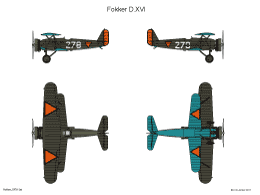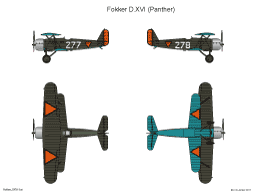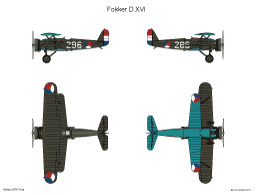Nederlandse Modelbouw en Luchtvaartsite
Dutch Modelling and Aviation
Fokker D.XVI
History
Early 1929, the LVA and Fokker signed a contract for two prototypes of a fighter.
Initially, two versions of the Fokker D. XV were in mind, where one would be a heavier one and the other a lighter version.
Finally the LVA chose the D.XVI, which was in a way a compromise.
In the summer of 1929 the first prototype was ready. A the second one was completed in February 1930.
It was designed by Reinhold Platz and was a half-plane with an Armstrong Siddeley Jaguar engine star Townend ring.
Initially, there were still some initial problems, but when these were resolved, it was a popular aircraft.
The machines of the LVA differed with respect to the prototypes in that the main axis of the landing gear was replaced by a separate suspension, the long strut style fuselage to the wing struts had been extinguished and the exhaust pipes were extended on both sides along the fuselage.
Fokker also built an example for the NEIAF, equipped with a 625 hp Curtiss Conqueror engine.
This aircraft made the first flight on August 20, 1930. The aircraft fell down while performing a tail-spin test during a test flight on March 20, 1931.
| Dimensions: | |||
| Wingspan: | 9,40 m | Length: | 7,20 m |
| Height: | 2,7 m | Wing area: | 185 m2 |
| Weights: | |||
| Empty weight: | 1050 kg | Max. start weight: | 1475 kg |
| Performances: | |||
| Max. speed: | 330 km/hr | Climbing speed: | - m.min |
| Range: | 770 km | Service ceiling: | 9400 m |
| Miscellaneous: | |||
| Engine type: | Armstrong Siddeley Jaguar VIIa rated 450 - 525 hp | ||
| Crew: | One aviator | ||
| Armament: | Two 7,9 mm machine guns | ||
In service with LVA.
In 1930, a series of twelve examples was ordered. The first prototype was not included in this order.
The second prototype was owned by Fokker and was used for demonstration purposes.
In July 1931, the first production machine was delivered an during the rest of the year the rest of the order was delivered.
Soon after delivery Fokker D.XVI 277 was equipped with an Armstrong Siddeley Panther IIIa radial engine of 575 hp.
In 1934 followed an order for another three aircraft to replace losses. For this order fuselages and wings from the reserves of the LVA were used.
Many problems were encountered with the engines, as these often jammed. This problem was solved as the LVB reeled off the pistons slightly.
A disadvantage was that the oil consumption rose considerably, so the Fokker D.XVI could now fly for one and a half hour, while there was fuel for three hours.
Another disadvantage was encountered, "flutter", that is the vibration of the wing, occurring during dives.
The speed could run up very high, while the speedometer was calibrated up to 450 km/h, but run on till the level of 250 km/h was reached for the second time.
During tests, however, the machine 276, was lost on January 15, 1932 by this "flutter", the pilot, esquire Wittert van Hoogland, survived the crash.
The result of an investigation was that aileron balance weights were added.
During 1932 the machines were equipped with two machine guns.
At the end of May 1936 the JaVA, JachtVlieg Afdeling, (Fighter Section) was transferred from Soesterberg to Schiphol. The JaVA was then equipped with Fokkers D.XVI and D.XVII.
Only the 277 remained at Soesterberg in the Flying School. In 1935 this aircraft had a new Armstrong-Siddeley Panther installed with a three-blade propeller. There were no machine guns installed, due to synchronization problems.
The idea was to create a new JachtGroep VeldLeger, (Fighter Group Army) to raise a section, that was to be equipped with the D.XVI and D.XVII. One had calculated there would be 20 aircraft left in 1938. This was considered to be a temporary solution pending new aircraft.
During 1938, the number of available D.XVIs was driven back, because the engines were warn and replacement engines were no longer available. A whole new type of engine was not considered viable, given the age of the aircraft.
During the mobilization in 1939 was only on D.XVI was in use by the second JaVA (II-1 2 = LVR). During 1939, all D.XVIs were withdrawn from us. The last one, no 278 was written off in late October. Only the 277 was still in use for the training of fighter Pilots and was moved to Texel in November 1939.
| Serials
Serials
| Constr. nr. Fuselage / Wing
Constr. nr. Fuselage / Wing
| Date in service
Date in service
| Date out of service
Date out of service
| Notes
notes
|
|---|---|---|---|---|
| 275 | 5167/5214 | 08-07-1929 | 1939 | Prototype; first flight July 1929; Equipped with a Jaguar engine |
| 276 (1) | 5168/5215 | 01-02-1932 | 10-1930 | 276 Prototype Sold to Romania for an International competition. |
| 276 (2) | 5271/5304 | 01-10-1931 | 15-01-1932 | Re-registered; Crashed near Soesterberg due to flutter. |
| 276 (3) | 5325 / 5314+5394 | 01-02-1934 | 23-09-1935 | Collapse with 283 |
| 277 | 5272/5305 | 01-07-1931 | 05-1940 | Equipped with Panther engine in July 1932; In 1935 engine replaced with another Panther engine plus three blade propeller; No armament Captured at Texel by the German |
| 278 | 5273/5306 | 01-08-1931 | 07-1939 | Written off |
| 279 (1) | 5274/5307 | 07-1931 ? | 09-1932 | |
| 279 (2) | 01-02-1934 | 03-1939 | Written off after engine failure and crash. | |
| 280 | 5275/5308 | 01-09-1932 | 07-1939 | Written off |
| 281 | 5276/5309 | 01-07-1931 | 1939 | Written off |
| 282 | 5277/5310 | 01-07-1931 | 1939 | Written off |
| 283 (1) | 5278/5311 | 01-08-1931 | 05-1935 | 17-02-1933 collapsed with 276; Written off |
| 283 (2) | 01-02-1934 | 1939 | Written off | |
| 284 | 5279/5312 | 01-08-1931 | 06-1936 | Written off |
| 285 | 5280/5313 | 01-09-1931 | 1939 | Written off |
| 286 | 5281/5314 | 01-09-1931 | 11-1938 | Written off |
| 287 | 5282/5315 | 01-09-1931 | 11-1938 | Written off |
| 288 | 5283/5316 | 01-09-1931 | 04-1935 | 14-03-1935 crashed near Gilze-Rijen; Written off |
| 289 | 5240/5276 | 01-08-1930 | 20-03-1931 | Test machine for NEIAF serialled "F-32", equipped with a Curtiss Conqueror V1570 Crashed near Schiphol |
1/72nd Scale
Kits
- MW Models
- Kit 72-01: resin kit with decals, based upon scratch built model by M. Schönfeld of IPMS Nl.
- Omega
- Kit 72403: Fokker DXVI "Panther".
Modelling add-on
- --
- Set --: --.
Decals
- --
- Set --: ---.
1/48th Scale
Kits
- --
- Kit --: --
Modelling add-on
- --
- Set --: --.
Decals
- --
- Set --: ---.
>
| Scheme | Colour name | WEM | Humbrol | XtraColor | Vallejo Model Color | Vallejo Model Air | |
|---|---|---|---|---|---|---|---|
| Standard #1 | Upper surfaces | LVA Khaki | AC D04 | 29? / 155? | x2? /x251? | 70.921? / 70.887? | |
| Undersides | LVA Blue | AC D05 | 115 ? | X-214? | |||
Check www.paint4models.com for an extensive conversion table with lots of colour and paint systems.

Fokker D.XVI: LVA khaki and LVA blue undersides and orange triangles as nationality markings (on remaining aircraft).

Fokker D.XVI: LVA khaki and LVA blue undersides and orange triangles as nationality markings and equipped with a Panther engine.
Only applicable to the 277, which was in use at the advanced training school at Texel.
Only applicable to the 277, which was in use at the advanced training school at Texel.
Literature.
| Nederlandse Militaire Luchtvaart in Beeld. deel 1. | Hugo Hooftman | Pag. 119 - 123 | 1977 | Uitgever: Europese Bibliotheek, Zaltbommel |
| Fokker,-vliegtuigen voor de Militaire Luchtvaart | Pag. 8 | 1982 | ||
| Fokker, Bouwer aan de wereldluchtvaart | Thijs Postma | Pag. 82 | 1979 | Uitgever: Unieboek b.v., Houten |
| De Nederlandse Vliegtuigen: Alle vliegtuigen ooit in Nederland ontworpen en gebouwd | Theo Wesselink & Thijs Postma | Pag. 73 | 1982 | Uitgever: Romen Luchtvaart, Haarlem |
| AVIA: 41e jaargang nummer 8: Botsing boven de Haarlemmermeer. Een botsing en een afscheid | H.J. van Overvest | Pag. 312 - 313 | 1982 | Uitgevers Wyt, Rotterdam |
| Luchtvaartwereld; 2e jaargang nummer 4: Fokker D.XVI | Frits Gerdessen | Pag. 121 - 125 | 1985 | Uitgeverij Ten Brink, Meppel |
| 40 Jaar luchtvaart in Indië | Gerard Casius & Thijs Postma | Pag. 34 | 1986 | Uitgeverij De Alk, Alkmaar |
| KLu Vliegtuigen: De vliegtuigen van de Koninklijke Luchtmacht vanaf 1913 | Wim Schoenmaker & Thijs Postma | Pag. 45 - 47 | 1987 | Uitgeverij De Alk, Alkmaar |
| Nederlandse Militaire Luchtvaart 12: Fokker D.16 | Frits Gerdessen | Pag | Uitgever: St. Vrienden v.h. Mil. Luchtv. Museum, Soesterberg | |
| Squadrons van de Koninklijke Luchtmacht (derde herzien druk) | Willem Helfferich | Pag. 16 - | 1994 | Uitgevers Wyt, Rotterdam |
| Camouflage en Kentekens | J.Greuter e.a. | 1997 | Bonneville – Bergen (NH) |
Websites.
Special thanks to mr P. Banis for the research on the serials.


